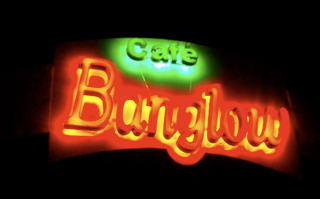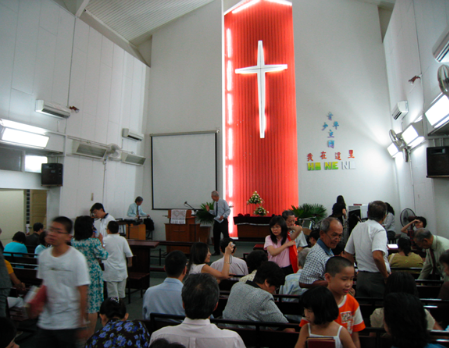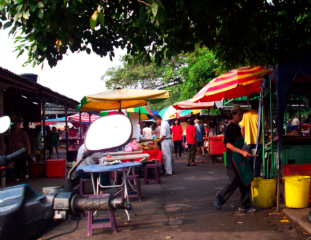Sitiawan will always be a place close to my heart...that's how one is supposed to feel about one's birth place, I suppose. Ask that to any CTA1 native and they'll probably repeat the same mantra....kompian, mee suah, kampuan, ko-ru, ko-rau-wu, chap-chai, ngi-pien..all of them your regular Fuchow favourites. Settlers were brought in at the turn of the 20th century from North Fujian to cultivate rice.
Why the Fuchows? Apparently the colonialists wanted a group that was not connected to any of the existing Chinese groups in Malaya then who had come from South China - the Cantonese, Hokkien, Hakka and Teochew. The Cantonese and Hakka were in the tin industry, the Hokkien in commerce and the Teochew in sugar, gambier and pepper cultivation. It was in this scenario that the Fuchows came into the picture....to be rice cultivators. But it was not to be. Rubber became their cash crop because of the timing. Early 20th century was experiencing fantastic demand for rubber. And rubber grew well in Sitiawan. Sitiawan prospered.
 My paternal grandfather fled China and came over here where he became a rubber tapper. Rubber tapping is hard work....more so for him because he was brought up privileged but because his family lost everything in the years culminating to the Opium War, he had to start with nothing.... He used to tell us how he had a tutor for martial arts, the Chinese classics when he was a kid...the life of the privileged class....all that gone!
My paternal grandfather fled China and came over here where he became a rubber tapper. Rubber tapping is hard work....more so for him because he was brought up privileged but because his family lost everything in the years culminating to the Opium War, he had to start with nothing.... He used to tell us how he had a tutor for martial arts, the Chinese classics when he was a kid...the life of the privileged class....all that gone!As a child growing up in Sitiawan, I remember cycling through the rubber estates and searching for the strongest rubber seed....we'd press 2 seeds against each other to see which one cracked! And that was fun.
 In later years, and also because of the economic downturns which affected the rubber plantation owners, many tried other crops. Oil palm has replaced most the the rubber plantations in recent years.
In later years, and also because of the economic downturns which affected the rubber plantation owners, many tried other crops. Oil palm has replaced most the the rubber plantations in recent years. And this...the swift started making their homes after one particular bad year of haze in Indonesia. That was back in 1989. It has brought wealth and changed the skyline of the town. Swifts now dwell among people in buildings built for people.
And this...the swift started making their homes after one particular bad year of haze in Indonesia. That was back in 1989. It has brought wealth and changed the skyline of the town. Swifts now dwell among people in buildings built for people.Was back recently and we took a walk around the Chinese Methodist Pioneer Church in Kg Koh. As a child I attended its Sunday school. This is the first place where I had my first experience of singing solo as a 6 year old. I came in third, I think. Many of my school mates started their Sunday school here too...so our friendship really goes back a long way.
 The above picture is the 'Moksu-Lau'. In Fuchow dialect it means Parsonage...home of the Pastor. I used to come to this place sometimes on Sundays when Pastor Yu was pastoring the church. It's now a Sitiawan Settlement Museum. A new Parsonage has been built at the back. Most of the early migrants were brought in by missionaries.
The above picture is the 'Moksu-Lau'. In Fuchow dialect it means Parsonage...home of the Pastor. I used to come to this place sometimes on Sundays when Pastor Yu was pastoring the church. It's now a Sitiawan Settlement Museum. A new Parsonage has been built at the back. Most of the early migrants were brought in by missionaries.The Fuchows, even in those early days understood the importance of education. Some historical recounts stated that they organised classes taught in Fuchow almost right from the time they settled here, even before they had permanent places to stay. Education has always been important. And for a small town like this, the number of her young people who made it to the local universities under our stiff NEP quota system and fierce competition is a testament to that. And this small town has produced many of the country's top scholars, both at SPM and STPM/HSC level. The legacy of the Fuchow attitude on education.... along the main road you can find more than 10 schools!
 Just a couple of feet away are wells dug to supply water to the town folks. Opposite the Parsonage is ACS Sitiawan, and right under the school's bus bay was once where the first well was dug. This well to Kg Koh residents was like what Perigi Hang Li Po was to the Malaccans. Words passed down had it that it gave out water of the best quality!
Just a couple of feet away are wells dug to supply water to the town folks. Opposite the Parsonage is ACS Sitiawan, and right under the school's bus bay was once where the first well was dug. This well to Kg Koh residents was like what Perigi Hang Li Po was to the Malaccans. Words passed down had it that it gave out water of the best quality! This is ACS Sitiawan...my alma mater. Started by a German missionary, Dr Leuring in 1904, his name remains in the school song till this day. It's a place where I spent 13 years of my life. By 1912 the medium of instruction was changed from Fuchow to English. And in 1916, Rev Horley renamed it ACS Sitiawan. The name has stayed since. ACS Sitiawan is unique in the sense that it is a co-ed school. There are other ACS in Malaysia but they are generally all boys school. It has produced many of Sitiawan's illustrious sons and daughters. I have many fond memories there....had great teachers who awed and inspired us!
This is ACS Sitiawan...my alma mater. Started by a German missionary, Dr Leuring in 1904, his name remains in the school song till this day. It's a place where I spent 13 years of my life. By 1912 the medium of instruction was changed from Fuchow to English. And in 1916, Rev Horley renamed it ACS Sitiawan. The name has stayed since. ACS Sitiawan is unique in the sense that it is a co-ed school. There are other ACS in Malaysia but they are generally all boys school. It has produced many of Sitiawan's illustrious sons and daughters. I have many fond memories there....had great teachers who awed and inspired us! This is planted right in front of the Sitiawan Settlement Museum. It gives a brief account of the establishment of the settlement.
This is planted right in front of the Sitiawan Settlement Museum. It gives a brief account of the establishment of the settlement. The Chinese Methodist Pioneer Church Building...this building was constructed in 1927. This is the flagship of all the churches in Sitiawan. There are so many churches in Sitiawan ... and they're conducted in English, Mandarin, Tamil and the local dialects. If you attend church in Kg China, you get to attend services conducted in Hokchian. In Simpang Tiga, church service was conducted in Kutien... such is the diversity even within one race.
The Chinese Methodist Pioneer Church Building...this building was constructed in 1927. This is the flagship of all the churches in Sitiawan. There are so many churches in Sitiawan ... and they're conducted in English, Mandarin, Tamil and the local dialects. If you attend church in Kg China, you get to attend services conducted in Hokchian. In Simpang Tiga, church service was conducted in Kutien... such is the diversity even within one race. The bell tower was added in 1955. Growing up as a kid and right up to the time I left Sitiawan, we could hear the church bell tolling on Sundays. How I miss that! And songs would be played through the loudspeakers. It's within earshot of my house.
The bell tower was added in 1955. Growing up as a kid and right up to the time I left Sitiawan, we could hear the church bell tolling on Sundays. How I miss that! And songs would be played through the loudspeakers. It's within earshot of my house.It's been an illustrious history for Sitiawan...I hope it will live on.





















































